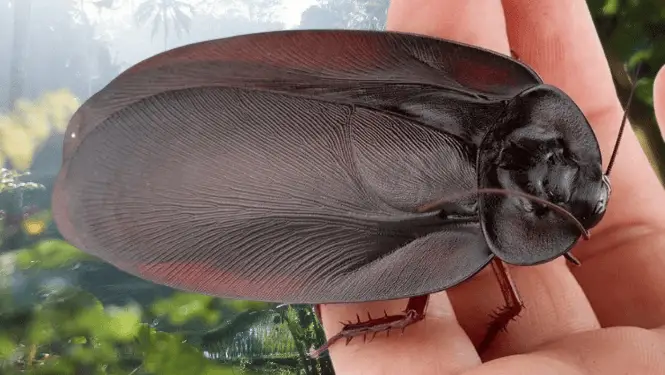Megaloblatta Longipennis

The incredible world of insects never ceases to amaze, with a variety of species that differ in shapes, sizes, and habits. Among them is the Megaloblatta longipennis, a species of cockroach that astounds experts and laypeople alike with its exceptional size.
Native to certain parts of South America, this creature has earned its place in the annals of entomology as one of the world’s most enormous cockroaches. We delve deep into the intriguing world of Megaloblatta longipennis, exploring its features, habitat, and life cycle.
Quick Facts
| Attribute | Details |
|---|---|
| Native Regions | Colombia, Ecuador, Peru |
| Length | Up to 9.7 cm (3.8 in) |
| Wingspan | Up to 20 cm (8 in) |
| Habitat | Rainforests, under leaves and logs |
| Diet | Decaying plant matter and organic material |
| Reproduction | Mates for up to 2 hours, lays 16-50 eggs |
| Life Stage Progression | Egg > Nymph > Adult |
| Lifespan | Up to 10 years (longer in captivity) |
Background
Megaloblatta longipennis belongs to the Ectobiidae family. Its native range encompasses countries like Colombia, Ecuador, and Peru. There have been reports of its presence in Panama.
Still, these are often based on misidentifications of the closely related Megaloblatta blaberoides, which is the only species from the Megaloblatta genus present in Central America.

Physical Attributes
Undoubtedly, the most jaw-dropping feature of Megaloblatta longipennis is its enormous size. The largest recorded specimen astonishingly measured 9.7 cm (3.8 in) in length and 4.5 cm (1.8 in) in width. Its wingspan reaches a staggering 20 cm (8 in), making it the world’s largest winged cockroach.
However, Megaloblatta blaberoides, a relative species, is quite close in size and can boast an almost equal length and a wingspan stretching up to 18.5 cm (7.3 in). Their physical similarity often leads to confusion in identification.
The dark brown coloration flat and oval-shaped body make Megaloblatta longipennis distinct. To put its size in perspective, while the average cockroach may range from 0.24 in-3 inches in length, this colossus can grow up to 3 and a half inches.
Habitat & Feeding Habits
As a nocturnal creature, Megaloblatta longipennis thrives in damp and dark spaces. They typically reside under logs, leaves, or in the thick underbrush of the rainforest.
Unlike many household cockroaches that have adapted to feed on human waste, Megaloblatta longipennis has a diet primarily consisting of decaying plant matter and other organic materials.

Reproductive Behavior
When it comes to reproduction, the male Megaloblatta longipennis courts a female, and upon her consent, they mate for a remarkable duration of nearly two hours.
Following their union, the female lays between 16 to 50 eggs, carefully placing them in concealed spots like under logs or within leaf litter.
Life Cycle & Longevity
The fascinating journey of a Megaloblatta longipennis starts as an egg. Upon hatching, they emerge as nymphs, resembling the adults but in a miniature form and devoid of fully developed wings.
The term “nymph” refers to their small stature and astonishingly swift growth. These nymphs undergo approximately seven molts before attaining adulthood.
Hatching after about two months, these nymphs’ rapid growth is genuinely fascinating. Adult Megaloblatta longipennis have been observed to live up to a decade in the wild, and intriguingly, they might live even longer in captivity.
Conclusion
Megaloblatta longipennis, with its immense size and intriguing life cycle, offers a captivating peek into the intricate tapestry of nature. For those interested in cockroaches or the broader world of entomology, this species stands out as a testament to the myriad wonders within our planet’s ecosystems.

James E. Butkovich, Pest control maven with a knack for eco-friendly & Chemical solutions. Blogger with a mission to make homes pest-free, one post at a time.